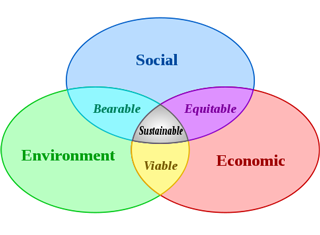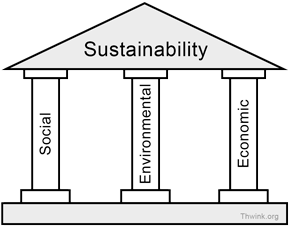Sustainability and the environment
Environmental sustainability is the rates of renewable resource harvest, pollution creation, and non-renewable resource depletion that can be continued indefinitely. If they cannot be continued indefinitely then they are not sustainable.

The Three Pillars of Sustainability
The principle of The Three Pillars of Sustainability says that for the complete sustainability problem to be solved all three pillars of sustainability must be sustainable. The three pillars are social sustainability, environmental sustainability, and economic sustainability.
Source: http://www.thwink.org/sustain/glossary/EnvironmentalSustainability.htm

Social sustainability is the ability of a social system, such as a country, family, or organization, to function at a defined level of social well being and harmony indefinitely. Problems like war, endemic poverty, widespread injustice, and low education rates are symptoms a system is socially unsustainable.
Environmental sustainability is the ability of the environment to support a defined level of environmental quality and natural resource extraction rates indefinitely. This is the world's biggest actual problem, though since the consequences of not solving the problem now are delayed, the problem receives too low a priority to solve.
Economic sustainability is the ability of an economy to support a defined level of economic production indefinitely. Since the Great Recession of 2008 this is the world's biggest apparent problem, which endangers progress on the environmental sustainability problem.
Source: http://www.thwink.org/sustain/glossary/ThreePillarsOfSustainability.htm
Environmental sustainability index (ESI)
The ESI was developed by Yale University and was published between 1999 and 2005. It tracked 21 measure of environmental sustainability including pollution levels and resource management. However, in 2005 it was decided to replace ESI with EPI. The EPI rather than comparing sustainability strategies of different countries, looked at outcome orientated indicators. The EPI places Iceland at the top of its index and Sierra Leone at the bottom.


Source: http://greenfieldgeography.wikispaces.com/Sustainability+and+the+environment
Korup National Park, Cameroon
The Korup Forest Dynamics Plot (KFDP) is located in the Korup National Park, along the western border of Cameroon and that contains one of Africa's richest rainforests -- an evergreen forest in a region of high, strongly seasonal rainfall (about 5.5m/yr). The plot was initiated in 1996, as a collaborative research effort between the BioResources Development and Conservation Program - Cameroon and the Center for Tropical Forest Science (CTFS) of the Smithsonian Tropical Research Institute (STRI), in conjunction with a medical drug discovery and biodiversity conservation project of the International Cooperative Biodiversity Group (ICBG).
The primary aim of the project was to apply information learned about forest dynamics and demographics to the discovery and development of potential new medicines from rainforest plants, with a focus on finding cures to malaria, leishmaniasis, HIV, and various other diseases with tropical origin. Today, the aim of the program has shifted towards promoting long-term scientific research for the conservation of biological diversity in Cameroon, with new partnership with the University of Buea, Cameroon, and the World Wide Fund for Nature, Cameroon Program.
Tree density in the Forest Dynamics Plot is very high, with a total of 329,000 individuals in the first census, averaging over 6,500 trees per hectare. A total of 494 species are found in the 50 ha with an average of 238 species per hectare.
Permission to conduct the field program in Cameroon is provided by the Ministry of Environment, Nature Protection and Sustainable Development.
Source: http://www.ctfs.si.edu/site/Korup






Source: http://www.slideshare.net/TheStuden-t/korup-a-conservation-project

No comments:
Post a Comment